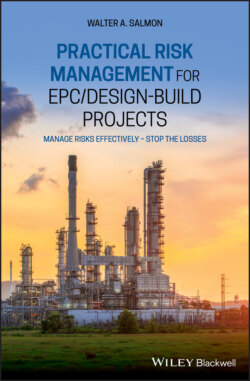Читать книгу Practical Risk Management for EPC / Design-Build Projects - Walter A. Salmon - Страница 36
3.6 Principal Disaster Areas on EPC Projects
ОглавлениеIn a nutshell, the ‘real and present danger’ for any EPC Contractor is the actual occurrence of any one of the following four disaster scenarios on its EPC Projects, since each issue mentioned is under the Contractor's direct control:
1 Time DisasterThe time for completion may be severely delayed due to poor management of the Engineering, Procurement, and/or Construction activities as well as the interfaces between them. This can then lead both to unrecoverable additional costs and the Contractor's income being seriously eroded due to the requirement to pay Liquidated Damages to the Employer to compensate for delayed completion.
2 Commercial DisasterEven if the Project is completed on time, the expenditure may significantly exceed the income due to the inadequacy of the Contractor's internal controls (not only in respect of purchases and subcontracted work but also for worker productivity and wastage levels).
3 Quality DisasterThe quality of the finished work may be well below the required standard. This could then lead to litigation over arguments as to whether or not the facility is suitable for its intended purpose. In the worst case scenario, it could lead to a complete breakdown of the facility and also involve loss of life.
4 HSE DisasterAn untoward health, safety, and/or environmental issue may cause a severe problem that could irreparably destroy the Contractor's reputation for a good while to come, as well as being costly to remedy (or provide compensation) for the negative effects experienced.
I have observed that far too few Contractors realise that, from the moment the Contract signing has been concluded, the Contractor has entered into the equivalent of a war zone, where time is the Contractor's principal enemy. The different ways in which time can be lost are many, some of which are almost indiscernible. Time moves along at a constant pace and is unrelenting in its progress, no matter how badly the Contractor needs to conserve time. The steady march of time steals meaningful progress from the Contractor in many areas of Project work, and its damage is very often added to by the Contractor's Team being too complacent or too slow to react to time being stolen. Consider, for example, the following non-exhaustive list of issues where time is more usually lost on Projects, many of whose causes (although not all) could be prevented with foresight:
1 late submission of Engineering Deliverables for review purposes by the Contractor's Engineering Team,
2 late review of Engineering Deliverables by the Employer's Team,
3 late receipt of Engineering Deliverables for Procurement and Construction purposes,
4 late placement of Purchase Orders,
5 late handing over of the Site,
6 late delivery of materials, goods, and equipment,
7 late instructions for changes arising from the Employer's side,
8 late mobilisation of construction equipment and manpower resources,
9 slow clearance of Punch Items, and
10 dealing with too much reworking, often at a late stage.
